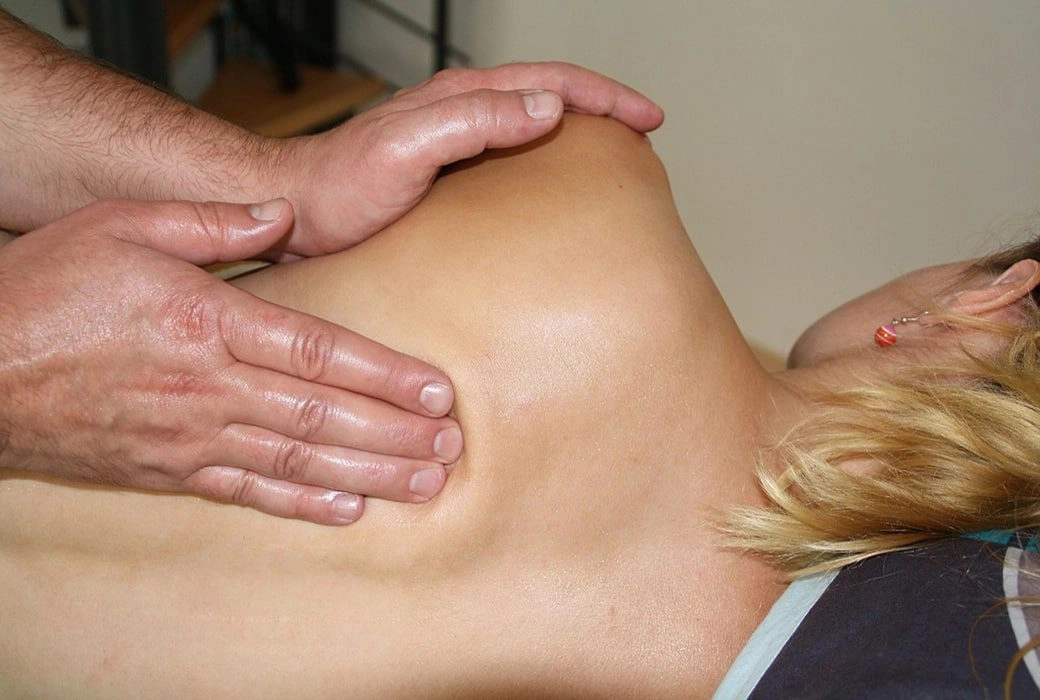At least 80 percent of all Americans will feel back pain at some point in their life. Back pain is so common that it is the #2 reason people go to the emergency room and the #1 reason people take time off from work. Here in Anchorage, our chiropractic team has been treating many different forms of back pain for over twenty-five years.
The majority of people who are diagnosed with bulging discs are between the ages of 30 and 50, although they can occur at any time, especially after trauma from car or bicycle accidents.
While there are many different causes of back pain, one of the most common is a herniated disc. With the increase in office jobs, obesity, and lack of exercise in our society, it’s no wonder that herniated disc problems are also on the rise.
The discs in the spine act like small pillows or cushions, preventing the bones from rubbing directly on one another. They work like shock absorbers in a car as well, absorbing motion when we move. When the disc becomes damaged, it can bulge out from between the vertebrae, causing pain as it touches the nerves.
Let’s talk about herniated discs, what you should do if you are feeling pain from one, and how your chiropractor can help.
Anchorage Chiropractor Explains: What is the Difference Between a Herniated Disc and a Bulging Disc?
Strain, pressure, or damage to the spine can cause the disc to flatten out and protrude from the vertebrae. This is considered to be a bulging disc.
A herniated disc is when a tear appears on the disc and the soft gel like inside is squished out, like a tube of toothpaste if you pressed it in the center too hard.
You might hear the term “slipped disc”, this is a misnomer as it is impossible for the disc to slip out from between the vertebrae. Most people mean a herniated disc when they refer to a slipped disc. A bulging disc is sometimes called a protruding disc, which would be accurate since it is protruding from between the vertebrae of the spine.
What Causes a Bulging Disc?
While there are many ways a disc can become injured, one of the primary causes is car accidents. There is also a genetic component in that some people simply have less flexible discs, leaving them more prone to injury. Repeated microtrauma to the disc, such as poor posture and repetitive movements, can also lead to bulging discs.
By the way, while most bulging discs occur in the lower back, they can and do happen in the neck as well.
People will feel the pain of a bulging disc from different activities, depending on where the disc is located and what nerve it is touching. Some feel it while sitting, others while lying on their back in bed, still others feel the pain when bending over, such as putting on shoes. This is why it takes a professional to help determine which disc is causing the pain, how it can best be resolved, and what steps you need to take to avoid pain while the disc heals.
Common Mistakes Explained by Top Anchorage Chiropractor
Of course, when it first hits, the pain of a bulging disc can be excruciating for some people. If this is the case, you most likely went to the emergency room for a short-term round of opioid pain killers.
Unfortunately, one of the biggest mistakes people make is that they continue to rely on pain killers rather than focus on healing their spine.
Another common mistake is to lie on the couch for the next few weeks, waiting for the pain to go away. Staying as active as possible is more vital than you realize. We discuss this in things #2 and 3.
Perhaps the third mistake people make is to delay treatment. After lying on the couch for weeks and taking pain meds, they suddenly realize that this isn’t going to go away on its own. Like many things in life, the earlier you begin treatment the better off you will be. While some might think that a bulging disc treatment can be done at home, you are far better off consulting a health care professional, such as your top Anchorage chiropractor. When it comes to the spine, chiropractors are experts at healing and manipulating bulging discs in the neck and spine.

Pain is your body’s way of telling you that something is wrong. While it might seem that resting will make your back pain go away, in this case, resting will only make pain worse.
If you think that you might be experiencing pain from a bulging disc, there are a few things that you must know:
Thing #1- Your Bulging Disc Probably Does Not Need Surgery
Surgery is rarely used for bulging or even herniated discs, even for those who are experiencing intense pain. Most people will experience the worst of their pain during what is called the acute phase, which is when you first realize there is a problem. Inflammation will need to be reduced and ice therapy, as well as keeping the spine in a neutral position so that there is little or no pressure on it, will be most helpful during this time.
As little as 10% of all people experiencing a bulging disc will benefit from surgery. Often times this only happens when all other treatment methods have failed, the patient is in a good deal of pain and/or the patient has other issues that prevent the disc from returning to its original place and shape.
Thing#2-Chances are Your Bulging Disc Can Be Healed
Bulging discs can be healed naturally by using holistic means and allowing time to run its course. How long does a bulging disc take to heal? That would depend on how severe the problem is and if the patient is willing to do what is necessary to allow the disc to heal. Most people find that with proper care and chiropractic treatment, their disc will heal in about 6-8 weeks.
One of the key elements is after a short period of rest, you need to stay as active as possible to avoid increased inflammation and the weakening of muscles which support the spine. While this might seem impossible, thing #3 will show you exactly how you can make this happen.
Thing #3-Chiropractic Care & Treatment are the Best Ways to Heal
During what is known as the sub-acute phase, chiropractic adjustments and massage therapy are very helpful at this time. Your Anchorage-based chiropractor can determine where in the spine the problem disc is located and pinpoint the cause. After a diagnosis using an MRI, your chiropractor will perform adjustments to help realign the vertebra, which will allow the disc to return to its natural shape and place in the spinal column.
Your chiropractor will most likely also perform other types of modalities, including chiropractic massage, ultrasound, Low Level Laser Light Therapy, and/or physical therapy, depending on what the doctor finds.

Studies show that subjects who received regular chiropractic care felt less pain and had fewer pain episodes than those who did not receive adjustments or other types of chiropractic treatment.
Exercises and physical therapy are very helpful during the sub-acute phase to improve range of motion and reduce pain. Your chiropractor can also offer you advise in this area as well, creating a specialized set of exercises and stretching routines for your unique situation. By strengthening your core muscles and using good lifting techniques, as well as regular chiropractic care to maintain the spine in its ideal position, you can heal a bulging disc, as well as prevent future bulging or herniated discs.
Thing #4-You Don’t Need Months of Addicting Pain Killers
A very short-term program of pain killers during the acute phase can be helpful, but continued use will result in addiction or overdependence. Over the counter pain killers can also be effective for short periods of time, but inflammation and healing of the disc will provide long term benefits that opioids cannot provide.

Your chiropractor can suggest an anti-inflammatory diet, as well as natural anti-inflammatory supplements that can greatly reduce the pain caused by inflammation. He can also advise you on avoidance of foods that lead to inflammation as well as lifestyle changes that can help your back to heal faster.
Thing #5-The Pain You Feel Elsewhere Might be a Bulging Disc
While some people feel cramps, painful muscle spasms, numbness or a pins and needle type feeling or shooting pain down the legs, or pain around the tailbone area, while other people can have a bulging or even herniated disc and be unaware of it.
When a bulging disc touches one of the nerves in the spinal column, the pain can be deceiving. While you might feel pain where the disc touches the nerve, it is not uncommon for the pain to be felt elsewhere in the body, such as in the legs or the buttocks.
Preventing a Recurrence

Of course, car accidents cannot be avoided. nor can you change your genetics, however, if the trauma to the disc was caused by repeated micro-trauma, your chiropractor can address the issue and show you the means of preventing a recurrence such as improving your posture or explaining better ways to lift. Regular chiropractic care can also go a long way towards preventing a recurrence.
Feel free to share this article with someone you feel could benefit from the information.
Schedule an Appointment, Receive a One-Hour Massage Certificate!
That’s right! Receive a certificate for a free one-hour massage with one of our highly-trained, professional, and licensed massage therapists for use after your first appointment. You can use it yourself, or give it to one of your family or friends for them to use! So, don’t forget to reach out to our chiropractic team based right here in Anchorage, AK. We can help.










